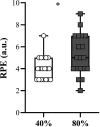Effects of light-load vs. heavy-load jump squats as priming activities in Olympic female rugby sevens players
- PMID: 40182726
- PMCID: PMC11963119
- DOI: 10.5114/biolsport.2025.142645
Effects of light-load vs. heavy-load jump squats as priming activities in Olympic female rugby sevens players
Abstract
Priming activities have been widely used by coaches as a strategy to enhance physical performance within short periods (6-24 hours) before sport-specific training sessions and competitions. In this crossover study, we examined and compared the effects of two different priming schemes on the speed-power performance of female rugby sevens players. One hour after completing a standardized warm-up and a series of measurements including loaded and unloaded jumps and speed-related tests, twenty Olympic female rugby sevens players performed, one week apart, 6 sets of 6 reps of jump-squats (JS) at either 40% (light-load; LL) or 80% 1RM (heavy-load; HL). Countermovement jump height increased significantly 6-h after both loading conditions (ES=0.50 and 0.34, for LL and HL, respectively; P < .001), with no changes observed at the 24-h time-point. JS peak velocity improved significantly after 24-h compared to the pre-testing, but solely for the lighter loading intensity (i.e., JS at 40%1RM; ES=0.63; P=0.006). 40-m sprinting speed increased significantly at the 6-h timepoint for both LL (ES=0.20; P=0.001) and HL (ES=0.18; P=0.004), without showing significant changes in the following 24-h. COD speed improved significantly after both priming schemes at the 6- and 24-h time points, regardless of the loading condition (P ≤ 0.027 for the main effect of time). No time × loading condition interaction was detected for any variable assessed, with P-values ranging from 0.111 to 0.953. Importantly, the rate of perceived exertion was significantly higher after the priming protocol at the HL condition (P=0.02), which may lead to increased levels of fatigue and decreased performance in subsequent activities. Elite coaches from rugby sevens (and other team sports) should strongly consider these findings when programming priming training sessions in the periods preceding more intensive training sessions and official matches due to the potential disadvantages associated with the use of heavier loads (i.e., ≥ 80% 1RM).
Keywords: Athletic performance; Ballistic exercises; Potentiation; Resistance training; Team-sports.
Copyright © Institute of Sport – National Research Instutite.
Conflict of interest statement
The authors declared no conflict of interest.
Figures





Similar articles
-
Effects of Loaded and Unloaded Jumps Used as Priming Activities in Elite Male Rugby Union Players.J Strength Cond Res. 2025 Jun 1;39(6):e781-e787. doi: 10.1519/JSC.0000000000005093. Epub 2025 Apr 23. J Strength Cond Res. 2025. PMID: 40267473 Clinical Trial.
-
Jump Squats Performed with Both Light and Heavy Loads Have Similar Effects on the Physical Performance of Elite Rugby Players during the Initial Phase of the Competitive Period.J Hum Kinet. 2024 Apr 15;91(Spec Issue):175-188. doi: 10.5114/jhk/186340. eCollection 2024 Mar. J Hum Kinet. 2024. PMID: 38689591 Free PMC article.
-
Comparison of the Potentiating Effect of Variable Load Jump Squats on Acute Drop Jump Performance in Rugby Sevens Athletes.J Strength Cond Res. 2023 Jan 1;37(1):149-160. doi: 10.1519/JSC.0000000000004214. Epub 2022 Jan 20. J Strength Cond Res. 2023. PMID: 36515600
-
A brief review of strength and ballistic assessment methodologies in sport.Sports Med. 2014 May;44(5):603-23. doi: 10.1007/s40279-014-0145-2. Sports Med. 2014. PMID: 24497158 Review.
-
Short-term Periodization Models: Effects on Strength and Speed-strength Performance.Sports Med. 2015 Oct;45(10):1373-86. doi: 10.1007/s40279-015-0355-2. Sports Med. 2015. PMID: 26133514 Review.
Cited by
-
Priming Exercises and Their Potential Impact on Speed and Power Performance: A Narrative Review.J Hum Kinet. 2025 Jun 25;98:153-168. doi: 10.5114/jhk/204371. eCollection 2025 Jul. J Hum Kinet. 2025. PMID: 40837515 Free PMC article. Review.
References
-
- Kempton T, Sirotic AC, Coutts AJ. A Comparison of Physical and Technical Performance Profiles Between Successful and Less-Successful Professional Rugby League Teams. Int J Sports Physiol Perform. 2017; 12(4):520–526. - PubMed
-
- Boullosa D. Post-activation performance enhancement strategies in sport: a brief review for practitioners. Human Mov. 2021; 22(3):101–109.
LinkOut - more resources
Full Text Sources
